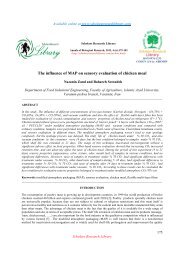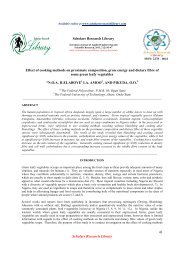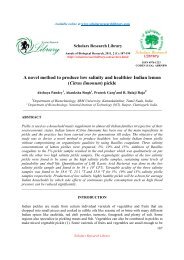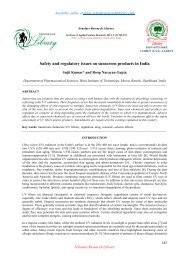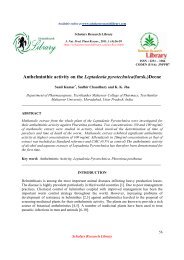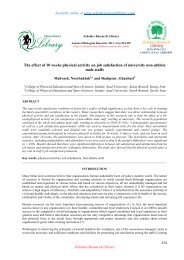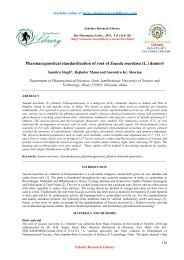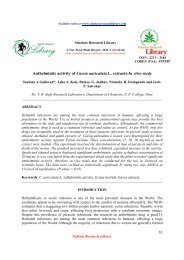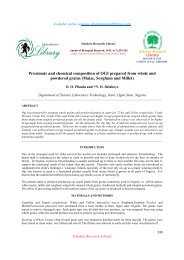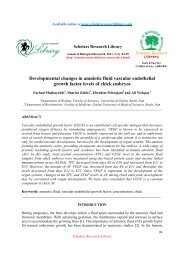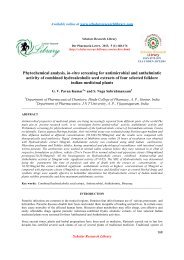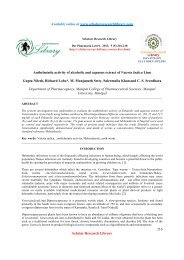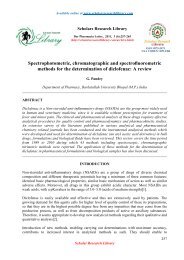Effect of Sacoglottis gabonensis (Urban humiraceae) - Scholars ...
Effect of Sacoglottis gabonensis (Urban humiraceae) - Scholars ...
Effect of Sacoglottis gabonensis (Urban humiraceae) - Scholars ...
Create successful ePaper yourself
Turn your PDF publications into a flip-book with our unique Google optimized e-Paper software.
Available online at www.scholarsresearchlibrary.com<br />
<strong>Scholars</strong> Research Library<br />
J. Nat. Prod. Plant Resour., 2013, 3 (2):52-56<br />
(http://scholarsresearchlibrary.com/archive.html)<br />
ISSN : 2231 – 3184<br />
CODEN (USA): JNPPB7<br />
<strong>Effect</strong> <strong>of</strong> <strong>Sacoglottis</strong> <strong>gabonensis</strong> (<strong>Urban</strong> <strong>humiraceae</strong>) stem bark extract, a palm wine<br />
additive on the rabbit jejunum<br />
Maspalma G .A 1 , Fariku S 1 , Manu J.M 2 , Ajide M.A 2<br />
1<br />
Department <strong>of</strong> Pure Sciences, College <strong>of</strong> Science and Technology, Adamawa State Polytechnic,<br />
P.M.B 2146, Yola, Nigeria.<br />
2 Department <strong>of</strong> chemistry, Modibbo Adama University <strong>of</strong> Technology, P.M.B 2076, Yola,<br />
Adamawa State. Nigeria.<br />
_________________________________________________________________________________<br />
ABSTRACT<br />
The crude extract from <strong>Sacoglottis</strong> <strong>gabonensis</strong> (<strong>Urban</strong> Humiriaceae) stem bark was prepared using standard<br />
method. The jejunum <strong>of</strong> the rabbit was obtained through dissection. About 2-3cm 3 <strong>of</strong> the isolated jejunum was<br />
mounted in an organ bath containing Tyrode solution at 37 o c ±1 o c.These investigation was carried out on the<br />
isolated jejunum. Result showed that the extract induce relaxation effect on the intestinal motility <strong>of</strong> the isolated<br />
rabbit jejunum, whereas the standard drug acetylcholine induced contraction effect. The log- dose response curve<br />
for the extract shows that at higher concentration <strong>of</strong> the added extract the response is lower, while in the case <strong>of</strong> the<br />
standard drug, the trend was reversed, thus increase in drug concentration increases the intestinal motility <strong>of</strong> the<br />
isolated rabbit jejunum, with increase in amplitude. From the result it is likely that the extract may cause diarrhea<br />
and the standard drug causes constipation.<br />
Key Words: <strong>Sacoglottis</strong> <strong>gabonensis</strong>, extract, stem bark, acetylcholine, relaxations and contraction.<br />
__________________________________________________________________________________________<br />
INTRODUCTION<br />
Plants have been used as a source <strong>of</strong> medicine throughout history and continue to serve as the basis for many<br />
pharmaceuticals used today. They provide a valuable source <strong>of</strong> therapeutic compounds because <strong>of</strong> their enormous<br />
biosynthetic capacity [1]. Natural plant products have been used in Nigeria especially in the tropical rainforest zone<br />
<strong>of</strong> southern Nigeria in local medicine practice but very little <strong>of</strong> such substances have been subjected to scientific<br />
verification. This has limited their introduction and use in orthodox pharmaceutical preparation.<br />
<strong>Sacoglottis</strong> <strong>gabonensis</strong> is a tropical rainforest tree found in the tropical rainforest region <strong>of</strong> Africa and America. It<br />
belongs to the family Humiriaceae. In certain rural communities <strong>of</strong> Nigeria especially Abia , Akwa- Ibom ,Rivers<br />
,Delta, Edo and Imo State ,the stem bark <strong>of</strong> this tree is commonly used as an additive to palm wine, a local alcoholic<br />
brew which is an exudates from the phloem <strong>of</strong> raphia and palm trees[2].<br />
Palm wine is a generic name for group <strong>of</strong> alcoholic beverage obtained by fermentation from the saps <strong>of</strong> palm trees.<br />
Freshly harvested unfermented sap is a clear colorless liquid with a sweet sugary taste and no alcohol content after<br />
sometimes, it gets fermented becomes milky and increasingly less sugary and develops intoxicating effect [3]. Upon<br />
<strong>Scholars</strong> Research Library<br />
52
Maspalma G .A et al J. Nat. Prod. Plant Resour., 2013, 3 (2):52-56<br />
______________________________________________________________________________<br />
fermentation by the endogenous micro flora <strong>of</strong> the palm, the sugar is converted into ethanol and organic acids<br />
resulting in the rapid deterioration <strong>of</strong> the organoleptic quality <strong>of</strong> the juice. This was reported to be due to suspension<br />
<strong>of</strong> living microorganism. The stem bark extract is normally added when the palm wine is fresh. It prolongs the shelf<br />
life <strong>of</strong> the palm wine and reduce foaming and effervescence. It impacts a bitter taste to the sugary palm wine<br />
thereby, making the beverage more tasty and acceptable with the amber color. It has been reported also that the tree<br />
bark extract <strong>of</strong> S. <strong>gabonensis</strong> delays the souring <strong>of</strong> palm wine, lowers its titratable acidity, but the palm wine<br />
becomes more alcoholic on standing [4]. Claim are unanimous among consumers <strong>of</strong> the bark extract treated palm<br />
wine that it is used as a spice to serve as heating agent in nursing, pregnant mothers and in the treatment and<br />
management <strong>of</strong> microbial infection like gonorrhea [5].The stem bark extract <strong>of</strong> Sacoglotiss <strong>gabonensis</strong> contains<br />
element (Fe,Zn, Mn,Cu) which take part in the oxidative reaction <strong>of</strong> anti oxidative enzymes in the body [6]. It is<br />
known to be inhibitory to Lactobacillus plantharum, Leuconostoc mesenteroides, Escherichia coli and Sarcina lutea<br />
isolated from palm wine [7].Neither the tree bark <strong>of</strong> S. <strong>gabonensis</strong> nor the crystalline C- glucoside ,(bergenin)<br />
isolated from it has been shown to posses any significant mammalian toxicity [8] The antioxidant potential <strong>of</strong> the<br />
stem bark on 2, 4 dinitrophenylhydrazine-induced membrane peroxidation in vivo has been reported [5]. The authors<br />
concluded that the mechanism <strong>of</strong> antioxidant action <strong>of</strong> the extract was multifactorial /multi-system involving<br />
inhibition <strong>of</strong> catalase, enhancing the superoxide dismutase (SOD) capability <strong>of</strong> the liver and red blood cells, and<br />
sparing tissue depletion/utilization <strong>of</strong> vitamin C (ascorbic acid) and vitamin E (tocopherol).<br />
Despite appreciable progress made in the managing <strong>of</strong> various diseases using convectional therapeutic schemes, the<br />
search for the control <strong>of</strong> such diseases continues.<br />
In the present study, our aim was to investigate the effect <strong>of</strong> ethanol extract <strong>of</strong> sacoglottis <strong>gabonensis</strong> on the small<br />
intestine.<br />
MATERIALS AND METHODS<br />
Plant material: Samples <strong>of</strong> fresh cuttings <strong>of</strong> <strong>Sacoglottis</strong> <strong>gabonensis</strong> stem bark were purchased from Abeokuta<br />
market, Ogun State Nigeria, wrapped in polythene bag and immediately upon return to Maiduguri refrigerated<br />
pending use. . The plants was identified and authenticated by a botanist in the Department <strong>of</strong> Biological Sciences <strong>of</strong><br />
the University <strong>of</strong> Maiduguri. Nigeria.<br />
Preparation <strong>of</strong> the extract: The pulverized bark <strong>of</strong> <strong>Sacoglottis</strong> <strong>gabonensis</strong> (215g) was weighed and exhaustively<br />
soxhlet-extracted with absolute ethanol for 3 hours. The extract was then evaporated under reduced pressure and<br />
kept in a refrigerator for pharmacological investigation.<br />
Preparation <strong>of</strong> standard drugs: Acetylcholine chloride a pharmacological drug (agonist) is manufactured by<br />
British drugs house chemical Poole, England. 1.00mg <strong>of</strong> the drug was weighed into a flask, 1ml <strong>of</strong> distilled water<br />
was added and the volume was made up to 10.0ml with distilled water, equivalent to 0.1mg/ml or 100ug/ml.1ml <strong>of</strong><br />
the 100ug/ml was made up to 10ml which is equivalent to 10ug/ml.<br />
Experimental animal: Rabbit <strong>of</strong> either sex were purchased and kept at the Experimental Animal House in the<br />
physiology and pharmacology unit <strong>of</strong> veterinary medicine department for a week on good feed and water every day.<br />
The experiments were performed on the rabbits in accordance with the guiding principle for the care and use <strong>of</strong><br />
laboratory animal approved by the University <strong>of</strong> Maiduguri, Nigeria.<br />
<strong>Effect</strong>s <strong>of</strong> the crude Extract on intestinal contraction: The rabbits were killed by stunning and then<br />
exsanguinated by cutting the throat .A midline incision was made at the abdomen to expose the small intestine. 2-<br />
3cm 3 was carefully cut and dropped into a beaker (bath) containing Tyrode solution (NaCl, KCl, MgCl 2 ,<br />
NaH 2 PO 4 .2H 2 O, NaHCO 3 , CaCl 2 and Glucose. One end <strong>of</strong> the jejunum was tied with thread to the bent end <strong>of</strong> the<br />
stylus tube, while the other ends to a frontal writing lever. The tissue was mounted into the bath <strong>of</strong> 50 cm 3 capacity.<br />
It was then allowed for about 30 minutes to stabilize in the bath at a temperature <strong>of</strong> 37 0 c ±1 0 c, through which air was<br />
bubbled before the start <strong>of</strong> any experiment.<br />
Normal contraction was noted at a speed <strong>of</strong> 0.1mm/s on the kymograph recording paper after which the extract was<br />
added at a concentration <strong>of</strong> 0.2cm 3 to the 50cm 3 tissue bath and allowed to act on the tissue for 30 seconds. The<br />
organ bath was drained and refilled with a fresh tyrode solution. The tissue was allowed to recover and stabilized for<br />
<strong>Scholars</strong> Research Library<br />
53
Maspalma G .A et al J. Nat. Prod. Plant Resour., 2013, 3 (2):52-56<br />
______________________________________________________________________________<br />
5 minute to attain the baseline <strong>of</strong> contraction. Various doses (0.2, 0.4, 0.6, 0.8, and 1.0cm 3 ) <strong>of</strong> the crude extract were<br />
added one after the other to the tyrode solution bathing the tissue. The organ was washed after each addition <strong>of</strong><br />
extract. The amplitude <strong>of</strong> contraction or relaxant effect was measured in centimeter. The increase or decreases in<br />
responses to standard drug and extract were plotted against their log-concentrations.<br />
RESULTS AND DISCUSSION<br />
The effect <strong>of</strong> sacoglottis <strong>gabonensis</strong> stem bark ethanol extract on the rabbit isolated jejunum and the standard drug<br />
(Acetylcholine) administered to achieve standard peak <strong>of</strong> contraction were studied, using Harvard kymograph<br />
recorder. The doses <strong>of</strong> extract added to the isolated rabbit jejunum have induced decrease in the length <strong>of</strong><br />
contracture (Table1).The extract exerted lowest response <strong>of</strong> 1.5mm at 0.20ugmL -1 and a maximum response <strong>of</strong><br />
2.9mm at 0.04ug mL -1 gut-bath. The effect <strong>of</strong> Saco glottis <strong>gabonensis</strong> on the rabbit isolated jejunum is noticed to be<br />
dose dependent; this is because as shown in Table 1 the extract-induced relaxation is dependent on the<br />
concentration <strong>of</strong> extract.<br />
Table 1: The <strong>Effect</strong> <strong>of</strong> Extract on the Rabbit Isolated Jejunum<br />
S/N Final bath Concentration. ( uglml) Log Concentration. Responses (mm)<br />
Control - - 3.4<br />
1 0.04 -1.4 2.9<br />
2 0.08 -1.1 2.8<br />
3 0.12 -0.9 2.7<br />
4 0.16 -0.8 2.1<br />
5 0.2 -0.7 1.5<br />
Table 2: The <strong>Effect</strong> <strong>of</strong> Acetylcholine on the Rabbit Isolated Jejunum<br />
S/N Final bath Concentration. (uglml) Log Concentration. Response in mm.<br />
Control - - -<br />
1 97.2 2.0 2.3<br />
2 194.4 2.3 2.6<br />
3 291.6 2.5 3.7<br />
4 388.8 2.6 4.1<br />
5 486 2.7 5.4<br />
-1.6 -1.4 -1.2 -1 -0.8 -0.6 -0.4 -0.2 0<br />
Log concentration(ug/g)<br />
Figure1: Log-dose response curve for extract.<br />
4<br />
3.5<br />
3<br />
2.5<br />
2<br />
1.5<br />
1<br />
0.5<br />
0<br />
Response (mm)<br />
<strong>Scholars</strong> Research Library<br />
54
Maspalma G .A et al J. Nat. Prod. Plant Resour., 2013, 3 (2):52-56<br />
______________________________________________________________________________<br />
Response(mm)<br />
6<br />
5<br />
4<br />
3<br />
2<br />
1<br />
0<br />
0 0.5 1 1.5 2 2.5 3<br />
Log concentration(ug/ml)<br />
Figure2: Log-dose response curve for standard drug (Acetylcholine).<br />
That is the higher the extract concentration, the greater the rabbit isolated jejunum induced relaxant effect. The log<br />
dose- response curve (Figure 1) shows that the response <strong>of</strong> the rabbit isolated jejunum to various doses <strong>of</strong> extract is<br />
also dose –dependent. It is clear that the amplitude shows a decreasing effect as a result <strong>of</strong> increase in the<br />
concentration <strong>of</strong> extract.<br />
The effect <strong>of</strong> the standard drug (Acetylcholine) on the rabbit isolated jejunum summarized in Table 2 shows induced<br />
increased contraction <strong>of</strong> the jejunum under the same temperature with significant changes. The drug exerted lowest<br />
response <strong>of</strong> 2.3mm at 97.2ugmL -1 gut –bath and maximum response <strong>of</strong> 5.4mm at 486.0ugmL -1 gut –bath. The result<br />
shows that the Acetylcholine (97.2-486.0ugmL 1) dose-dependently increase the amplitude <strong>of</strong> contraction in the<br />
jejunum as shown in the log dose-response curve in (Figure 2).The increase in amplitude as a result <strong>of</strong> increase in<br />
the concentration <strong>of</strong> the drug could probably be due to the enhancement <strong>of</strong> the slow wave activity by the drug. Slow<br />
wave can normally be recorded in both circular and longitudinal muscles <strong>of</strong> the small intestine [9].<br />
They are produced by specialized pacemaker cells located in the circular and longitudinal muscle layer <strong>of</strong> the<br />
intestine [10].<br />
In conclusion, the ethanol extract <strong>of</strong> the bark <strong>of</strong> sacoglotis <strong>gabonensis</strong> has produced relaxant effect in response to<br />
the intestinal jejunum; the standard drug caused increased contraction and is capable <strong>of</strong> stimulating the muscarinic<br />
cholinoceptors. The relationship between drug concentration and the magnitude <strong>of</strong> the response that is observed is<br />
not complicated, hence from the result it is likely that the standard drug may cause diarrhea while the extract may<br />
cause constipation.<br />
Acknowledgement<br />
The authors are grateful to the Staff <strong>of</strong> Chemistry department and also the Physiology and Pharmacology department<br />
<strong>of</strong> the University <strong>of</strong> Maiduguri, Borno State, Nigeria, more especially Mr. Fine Akawo for carryout the extraction<br />
processes.<br />
REFERENCES<br />
[1] Itokawa H, S.L Morris-Natchile, T.Akiyama and K.H Lee (2008). Nat. Med. 62:263-280.<br />
[2] 2 .Okoye Z.S.C (2001): Journal <strong>of</strong> Biochemistry. vol.11 (2):79-93<br />
[3] Elijah, A.I, Ojimelukwe P.C, Ekong U.S and Asamudo N.U (2010): African Journal <strong>of</strong> Biotechnology. Vol.9 (35)<br />
5730-5734.<br />
[4] Morah F.N (1995): Journal <strong>of</strong> Food chemistry.53:153-155.<br />
[5] Maduka H.C.C (2005): Journal <strong>of</strong> Gastroenterology Vol. 3(2) 34-38<br />
[6] Maduka H.C.C and Okoye Z.S.C (2002): Pakistan Journal <strong>of</strong> Biological Sciences Vol.5 (1):66-68.<br />
[7] Ojimelukwe,P.C(2001): Journal <strong>of</strong> Food Biochemistry.25:411-424.<br />
[8] Okafor, N (1975): Journal <strong>of</strong> Applied.Bacteriology.38:1-7.<br />
<strong>Scholars</strong> Research Library<br />
55
Maspalma G .A et al J. Nat. Prod. Plant Resour., 2013, 3 (2):52-56<br />
______________________________________________________________________________<br />
[9] Ward, S.M, Beckett E.A.H, Wang X.Y, Baker F, Khoyi ,M and Sander ,K,M (2000): Journal <strong>of</strong><br />
Neuroscience.20:1393-1403.<br />
[10] Torihashi,S ,Fujimoto T, Trost C and Nakayama,S(2002); Journal <strong>of</strong> Biology and Chemistry. 227:19191-19197.<br />
<strong>Scholars</strong> Research Library<br />
56



